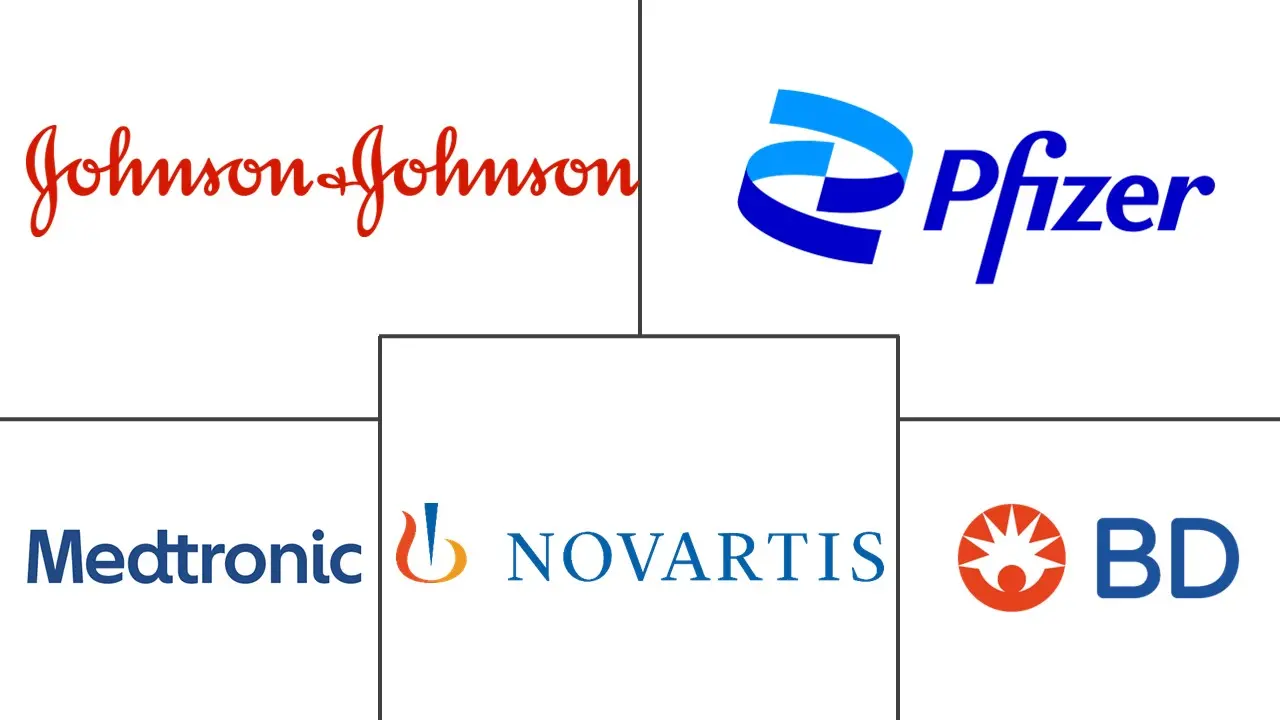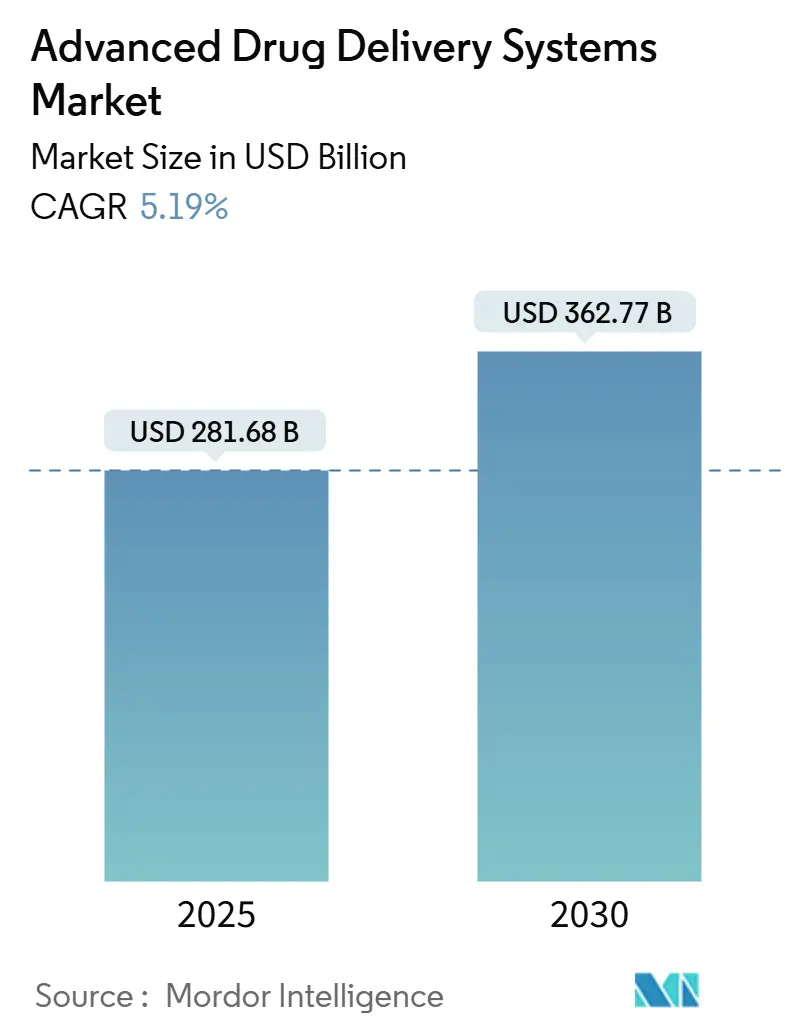
Advanced Drug Delivery Systems Market Analysis by Mordor Intelligence
The advanced drug delivery systems market is valued at USD 281.68 billion in 2025 and is forecast to reach USD 362.77 billion by 2030, expanding at a 5.19% CAGR. This steady climb reflects how sustained biologics innovation, nano-carrier breakthroughs, and patient-centric care models are reshaping therapeutic delivery. Lipid‐based nanoparticles, which already dominate formulation choices, are gaining traction in mRNA and siRNA pipelines, while smart electro-responsive implants show the fastest volume growth as they automate drug release in real time. Therapeutic demand concentrates in oncology, yet ophthalmology now logs the quickest rise owing to sustained-release ocular implants and drug-eluting contact lenses. Regionally, the advanced drug delivery systems market continues to lean toward North America, but Asia-Pacific’s regulatory convergence and low-cost production capacity are closing the gap. Competitive momentum intensifies as large pharmaceutical companies acquire agile platform developers to secure pipeline access and shorten launch timelines.[1]Novel Drug Delivery Systems: An Important Direction for Drug Innovation Research and Development, National Center for Biotechnology Information, pmc.ncbi.nlm.nih.gov
Key Report Takeaways
- By technology platform, lipid-based nanocarriers held 27.44% of the advanced drug delivery systems market share in 2024, while smart implantables and electro-responsive systems are projected to expand at a 9.57% CAGR to 2030.
- By application, oncology led with 30.27% revenue share in 2024; ophthalmology is forecast to grow at a 9.22% CAGR through 2030.
- By end-user, hospitals and clinics commanded 56.32% of the advanced drug delivery systems market size in 2024, while home-care and self-administration segments are advancing at an 8.59% CAGR.
- By geography, North America accounted for 37.47% of the advanced drug delivery systems market share in 2024; Asia-Pacific is set to expand at an 8.16% CAGR to 2030.
Global Advanced Drug Delivery Systems Market Trends and Insights
Drivers Impact Analysis
| Driver | ( ~ ) % Impact on CAGR Forecast | Geographic Relevance | Impact Timeline |
|---|---|---|---|
| Biologics pipeline expansion | +1.2% | Global; strongest in North America and EU | Medium term (2-4 years) |
| Nano-carrier design breakthroughs | +0.9% | Global; APAC manufacturing hubs lead | Long term (≥ 4 years) |
| Chronic-disease prevalence & adherence focus | +0.8% | Global; amplified in aging economies | Long term (≥ 4 years) |
| Venture funding for platform DDS start-ups | +0.6% | North America & EU; APAC rising | Short term (≤ 2 years) |
| Micro-reservoir implants for digital therapeutics | +0.4% | North America & EU early adopters | Medium term (2-4 years) |
| 3D-printed personalized dosage forms | +0.3% | EU leads; North America follows | Long term (≥ 4 years) |
| Source: Mordor Intelligence | |||
Biologics Pipeline Expansion
A widening biologics pipeline is reshaping delivery demands as proteins, antibodies, and nucleic-acid therapies require carriers that protect fragile structures and target complex tissues. Pfizer’s partnership with Bar-Ilan University on DNA nanorobots illustrates the push to marry biologic payloads with precision carriers. Oncology programs underscore this need: biologics now form more than 60% of active cancer trials, prompting delivery designs that cross vascular and cellular barriers without compromising potency. Combination products, such as Johnson & Johnson’s AKEEGA dual-action tablet, highlight how integrating two distinct mechanisms in one delivery format can cut disease progression by nearly half in BRCA-altered prostate cancer.
Nano-carrier Design Breakthroughs
Recent nano-carrier design wins are improving cell uptake, immune evasion, and payload capacity. Cubosome formulations achieve up to eight-fold greater cellular entry than traditional liposomes by fusing directly with membranes.[2]Lipid Nanoparticle Structure Shapes Cell Uptake, RMIT University, phys.org Ganglioside-based lipid nanoparticles remove PEG yet maintain stealth capabilities, addressing false-positive immunogenicity concerns.[3]Ganglioside-Incorporating Lipid Nanoparticles, Royal Society of Chemistry, pubs.rsc.org Artificial-intelligence screening now evaluates tens of millions of ionizable lipid candidates in silico, compressing discovery cycles and yielding delivery vectors optimized for mRNA therapeutics. Oregon State University’s lung-targeting nanoparticles extend these advantages into cystic fibrosis gene therapy trials.
Chronic-disease Prevalence & Adherence Focus
Relentless growth of chronic illnesses is fueling demand for devices that lessen dosing frequency and support home use. MIT’s ingestible capsule injects large-molecule drugs into the intestinal wall without needles, offering a future oral alternative for insulin or RNA therapies. Medtronic’s interoperable insulin pump links continuous glucose data with automated dosing to reduce burden on diabetes patients. Rice University’s biodegradable microcylinders release drugs steadily for up to five weeks, cutting refill frequency and bolstering adherence. The economic urgency is clear: US non-adherence still costs more than USD 100 billion yearly.
Venture Funding for Platform DDS Start-ups
Investors now view delivery technology as a scalable platform, not just a component of one therapy. BioSapien attracted USD 5.5 million for its 3D-printed localized oncology depot. Astraveus secured EUR 16.5 million to automate microfluidic cell and gene therapy manufacturing, aiming to trim production costs and timelines. NanoMedical Systems raised USD 7.21 million to adapt semiconductor processes for subcutaneous depots that meter medicine over months. Such rounds indicate growing confidence in plug-and-play platforms that can pivot across disease areas.
Restraints Impact Analysis
| Restraint | ( ~ ) % Impact on CAGR Forecast | Geographic Relevance | Impact Timeline |
|---|---|---|---|
| Batch-to-batch complexity & recalls | -0.7% | Global; stricter in North America & EU | Short term (≤ 2 years) |
| Stringent CMC & combination-product regulation | -0.5% | Global; FDA/EMA lead | Medium term (2-4 years) |
| Cold-chain cost escalation for biologic DDS | -0.4% | Global; heavier in emerging markets | Medium term (2-4 years) |
| Nano-carrier environmental toxicity concerns | -0.3% | EU scrutiny sets precedent | Long term (≥ 4 years) |
| Source: Mordor Intelligence | |||
Batch-to-batch Complexity & Recalls
The FDA’s 2025 guidance on uniformity pressures manufacturers to adopt real-time analytics and continuous processing. Minor particle-size shifts in lipid nanoparticles can alter biodistribution and efficacy, exposing companies to costly recalls. Continuous manufacturing promises tighter control but demands high capital outlay and extensive validation, straining smaller firms.
Stringent CMC & Combination-product Regulation
Hybrid drug-device products blur oversight boundaries. The FDA’s draft guidance on essential device outputs for drug delivery adds new verification layers, extending development timelines. Nanomedicine dossiers now require full mechanistic toxicology studies. Latin American authorities still request country-specific artifacts, complicating global launches.
Segment Analysis
By Type: Oral Dominance Faces Transdermal Disruption
Oral formulations retained 45.32% revenue share of the advanced drug delivery systems market in 2024, supported by familiar dosing and efficient manufacturing. Transdermal platforms are gaining at a 7.35% CAGR as microneedle patches and permeation enhancers deliver biologics without injections. The advanced drug delivery systems market size for oral products is projected to expand steadily, yet its share may slip as injectables and inhalables capture molecules that degrade in the gut. 3D-printed multilayer tablets, now in pilot production, show how oral systems will evolve to support precision dosing. Meanwhile, transdermal candidates leverage biodegradable microneedles that dissolve after insertion, eliminating sharp-waste handling. Pharmaceutical companies allocate R&D budgets toward long-acting transdermal contraceptives and hormone therapies that promise monthly or quarterly replacement cycles, boosting adherence and reducing clinic visits.
Patient acceptance drives this shift. Surveys indicate that more than 70% of adults prefer patch-based administration when equivalent efficacy is assured. Drug developers also appreciate the lower regulatory burden for line-extension strategies in transdermal formats because many excipients already hold GRAS status. However, achieving consistent flux across variable skin types remains a technical barrier. Collaborations with dermatology specialists aim to refine formulation rheology and backing-layer design to mitigate these challenges.

Note: Segment shares of all individual segments available upon report purchase
By Application: Oncology Leadership Challenged by Ophthalmology Surge
Oncology therapies commanded 30.27% of 2024 sales, a reflection of complex payload requirements and willingness to pay for targeted carriers. The advanced drug delivery systems market size for oncology is set to remain dominant as CAR-T, ADC, and radioligand pipelines reach commercialization. Johnson & Johnson’s TAR-200 intravesical system achieved an 82.4% complete response in bladder cancer, underscoring the potential of site-directed depots. Ophthalmology, however, grows fastest on the back of sustained-release implants like bimatoprost intracameral rings and anti-VEGF reservoirs. These devices cut injection frequency from monthly to twice yearly, reducing clinic burden.
Long-acting ocular inserts also widen chronic glaucoma coverage in regions with limited specialist access. Cardiovascular applications adopt biodegradable polymer stents that elute antiproliferative agents, while metabolic disorders advance weekly injectable GLP-1 analogs. Central nervous system indications face the blood-brain barrier hurdle, prompting research into focused ultrasound-activated carriers and intranasal routes that bypass systemic circulation.
By Technology Platform: Lipid Carriers Lead While Smart Systems Accelerate
Lipid nanoparticles, liposomes, and solid lipid carriers delivered 27.44% of 2024 revenue. Their modular structure suits both hydrophilic and lipophilic cargos, and scalable microfluidic manufacturing keeps costs predictable. Yet smart electro-responsive implants are on course for a 9.57% CAGR. These systems couple sensors with micro-pumps to adjust doses in real time, a transformative step for fluctuating conditions such as chronic pain. Polymeric carriers, including PLGA microspheres, maintain relevance by offering months-long depot action without hardware.
Targeted ligand-conjugated nanoparticles exploit tumor or tissue receptors to boost local concentrations while minimizing off-target impact. 3D printing supports prototype devices with integrated microfluidic channels, reducing iteration cycles from months to days. Microneedle arrays gain momentum for vaccines and biologics, as dissolving tips carry freeze-dried payloads that rehydrate in situ. The advanced drug delivery systems industry views combinatorial platforms—such as lipid-polymer hybrids—as a route to balance stability with responsive release.
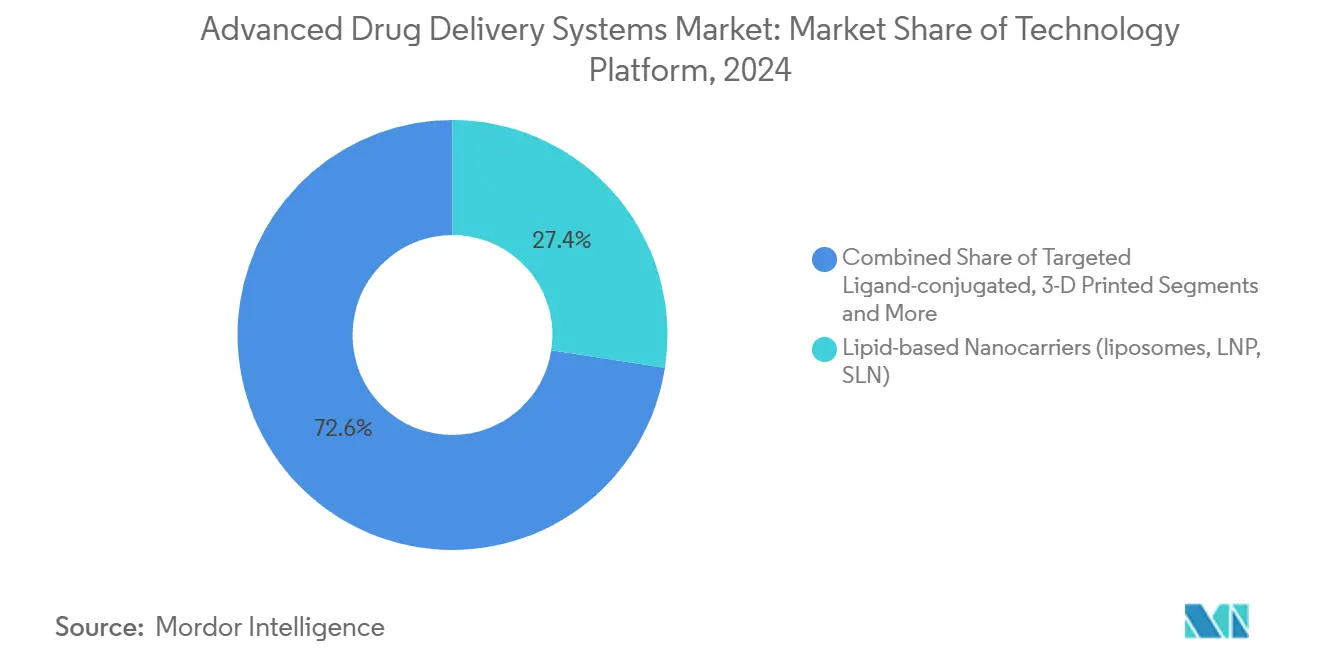
Note: Segment shares of all individual segments available upon report purchase
By End-user: Hospital Dominance Shifts Toward Home Care
Hospitals and clinics held 56.32% share in 2024 thanks to infrastructure for infusion, monitoring, and complex dosing. Home-care and self-administration services, however, grow at 8.59% as payers encourage decentralized care. Remote-programmed auto-injectors, connected inhalers, and weekly oral capsules all support this migration. The advanced drug delivery systems market share for home-care segments should rise as Medicare and private insurers shift reimbursement toward outcome-based models that reward adherence.
Ambulatory specialty centers bridge inpatient and outpatient settings, providing oncology infusion suites and same-day procedures. Contract research and manufacturing partners supply customized micro-batch production, enabling rapid scaling of niche personalized therapies. Academic labs partner with start-ups to translate bench discoveries into GMP-ready candidates.
Geography Analysis
North America retained 37.47% revenue share in 2024, buoyed by a mature reimbursement system, deep venture pools, and the FDA’s support for innovative manufacturing pathways. The region also houses major contract manufacturers that can scale lipid nanoparticle production within validated clean-room suites. Johnson & Johnson allotted USD 1.56 billion for advanced delivery technologies within its MedTech division, ensuring sustained pipeline throughput. Novartis opened an Indianapolis radioligand facility to support targeted prostate cancer therapy, signaling confidence in complex carrier formats.
Asia-Pacific, expanding at an 8.16% CAGR, capitalizes on lower fabrication costs and robust government incentives. China channels public funds into nanotechnology hubs, while South Korea’s semiconductor expertise accelerates smart implant production. India’s pharmaceutical base is upgrading to accommodate sterile lipid nanoparticle lines, leveraging Make-in-India subsidies. Regulatory agencies across ASEAN align more closely with ICH guidelines, smoothing multi-country approvals.
Europe remains influential through rigorous safety standards and green manufacturing priorities. EMA’s guidance on nanotoxicology drives global benchmarks, compelling developers to adopt biodegradable excipients. Germany’s precision-engineering firms supply micro-molding equipment for implant housings, and Switzerland’s biotech cluster advances antibody-drug conjugate delivery. Post-Brexit, the United Kingdom implements accelerated pathways to keep pace with US fast-track programs.
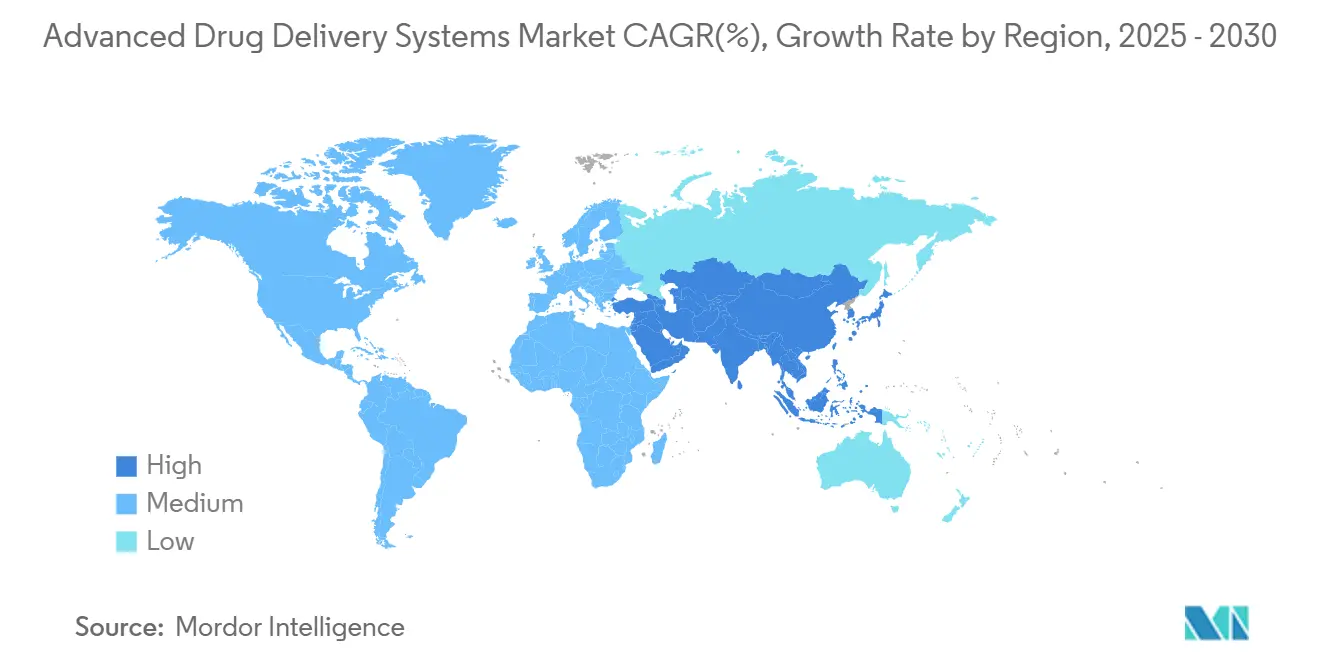
Competitive Landscape
Competition spans pharmaceutical majors, mid-size device specialists, and venture-backed start-ups. Lipid nanoparticle production is relatively concentrated; firms with proprietary microfluidic reactors enjoy scale and quality advantages. Conversely, 3D-printed dosage forms remain fragmented as universities and early-stage companies experiment with printer architectures and photopolymer chemistries. Johnson & Johnson, Pfizer, Abbott, Medtronic, and Novartis collectively owned roughly one-third of global revenue in 2024, indicating a moderate consolidation trend.
Strategically, players shift toward platform versatility. Acquiring modular delivery technologies reduces time to market across therapy areas. Manufacturing innovation also drives differentiation: continuous processing lines cut changeover times, and inline spectroscopy verifies critical quality attributes without halting production. Artificial-intelligence tools fine-tune formulation parameters, predicting stability profiles and scaling needs faster than empirical trial-and-error.
Disruptors target immuno-oncology with cell-derived “attack particles,” challenge-testing the boundaries of conventional carrier thinking. Start-ups also pursue oral biologic routes, believing patient convenience will command premium pricing. Established firms answer by deepening collaborations with contract development and manufacturing organizations, exemplified by Samsung Biologics’ USD 223 million expansion of its Baxter partnership.
Advanced Drug Delivery Systems Industry Leaders
-
Boston Scientific Corporation
-
Becton, Dickinson and Company
-
Pfizer Inc
-
Novartis
-
Medtronic plc
- *Disclaimer: Major Players sorted in no particular order
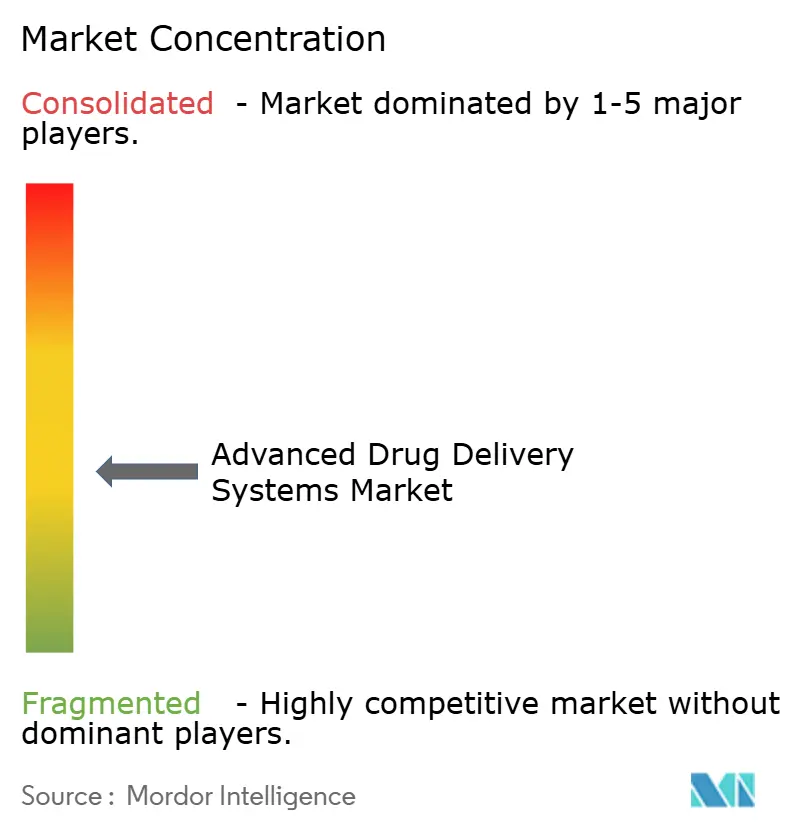
Recent Industry Developments
- June 2025: Johnson & Johnson received FDA approval for IMAAVY (nipocalimab-aahu) for generalized myasthenia gravis.
- June 2025: Johnson & Johnson reported 5-year remission in 33% of multiple-myeloma patients treated with CARVYKTI.
- April 2025: Medtronic filed 510(k) submissions for an interoperable insulin pump and automated glycemic controller.
Research Methodology Framework and Report Scope
Market Definitions and Key Coverage
Our study defines the advanced drug delivery systems (ADDS) market as all finished dosage forms and enabling platforms that deliberately modify the spatial or temporal profile of active pharmaceutical ingredients, including oral controlled-release tablets, injectable depots, transdermal patches, inhalable devices, smart implantables, and nanocarrier formulations. Value is captured at the point a finished product is commercialized or supplied for clinical use.
Scope exclusion: pure play contract development services, primary packaging, and legacy conventional syringes are not counted within this market.
Segmentation Overview
- By Type
- Oral Drug Delivery System
- Injection-based Drug Delivery System
- Inhalation/Pulmonary Drug Delivery System
- Transdermal Drug Delivery System
- Trans mucosal Drug Delivery System
- Carrier-based Drug Delivery System
- Other Types
- By Application
- Oncology
- Cardiovascular
- Metabolic (Diabetes, Obesity)
- CNS Disorders
- Infectious Diseases
- Ophthalmology
- Urology & Women’s Health
- Others
- By Technology Platform
- Pro-drug & Stimuli-responsive
- Lipid-based Nanocarriers (liposomes, LNP, SLN)
- Polymeric Nanocarriers (PLGA, PEG, micelles)
- Targeted Ligand-conjugated
- Smart Implantables & Electro-responsive
- 3-D Printed & Micro-needle
- Others
- By End-user
- Hospitals & Clinics
- Home-care & Self-administration
- Specialty & Ambulatory Centers
- CRO / CDMO & Academic Labs
- By Geography
- North America
- United States
- Canada
- Mexico
- Europe
- Germany
- United Kingdom
- France
- Italy
- Spain
- Rest of Europe
- Asia-Pacific
- China
- Japan
- India
- Australia
- South Korea
- Rest of Asia-Pacific
- Middle East and Africa
- GCC
- South Africa
- Rest of Middle East and Africa
- South America
- Brazil
- Argentina
- Rest of South America
- North America
Detailed Research Methodology and Data Validation
Primary Research
Mordor analysts interviewed R&D directors at pharmaceutical firms, hospital pharmacists across North America, Europe, and Asia, and device engineers at delivery platform suppliers. These discussions helped us stress test adoption rates, average selling prices, and region-specific reimbursement hurdles before locking key assumptions.
Desk Research
We began by mapping the technology and disease landscape through open sources such as the US FDA Drugs@FDA database, the European Medicines Agency approvals list, the National Cancer Institute pipeline tracker, and statistics from the International Diabetes Federation. Supplementary insights were drawn from trade associations (Parenteral Drug Association, Controlled Release Society) alongside peer-reviewed papers indexed in PubMed that discuss nanocarriers and microneedle platforms. Company 10-K filings, investor decks, and clinical trial registries provided dosage volumes, pricing brackets, and launch timelines that underpin our revenue curves. Paid repositories like D&B Hoovers and Questel supported cross-checks on manufacturer finances and patent activity. This inventory of sources is illustrative; many additional references informed data validation and clarification.
Market-Sizing & Forecasting
A top-down construct, starting with published global pharmaceutical sales, biologics share, and therapy area prevalence, was rebuilt into the ADDS addressable pool through penetration rate assumptions for each delivery route. Results are corroborated with selective bottom-up approximations (sampled ASP × annual unit output for leading products) to fine-tune totals. Variables guiding the model include chronic disease incidence, number of biologic approvals, injectable device shipments, nanocarrier patent grants, regulatory fast-track designations, and average treatment adherence. Multivariate regression, combined with scenario analysis for price erosion, drives the 2025-2030 forecast horizon. Any data voids in bottom-up splits are bridged by proxy indicators such as silicone patch substrate imports or vial stopper demand.
Data Validation & Update Cycle
Outputs pass three layers of review: automated variance checks against historical series, peer review by a senior analyst, and follow-up calls with earlier respondents when anomalies surface. Reports refresh yearly, while material regulatory or merger events trigger interim updates; a last-mile review ensures clients receive the freshest view.
Why Mordor's Advanced Drug Delivery Systems Baseline Earns Confidence
Estimates published by different firms often diverge because each selects unique service scopes, pricing ladders, and currency conversion dates.
Key gap drivers typically stem from whether pipeline launches are embedded, how carrier-based platforms are treated, and the cadence at which aging products are rebased. Mordor's disciplined scope and annual refresh keep our baseline aligned with real-world revenue flows, whereas others may lean on narrower or bundled definitions.
Benchmark comparison
| Market Size | Anonymized source | Primary gap driver |
|---|---|---|
| USD 281.68 B (2025) | Mordor Intelligence | |
| USD 269.99 B (2024) | Global Consultancy A | Combines conventional devices with ADDS, compressing scope distinctions |
| USD 269.48 B (2025) | Trade Journal B | Adds CDMO service revenue and hardware sales, inflating totals |
| USD 262.60 B (2023) | Industry Association C | Uses historical vendor revenue only, omitting near-term launches |
In short, Mordor's clear boundaries, variable-level transparency, and systematic recalibration give decision makers a balanced, reproducible reference point they can trust.
Key Questions Answered in the Report
1. What is the current size of the advanced drug delivery systems market?
The market is valued at USD 281.68 billion in 2025 and is projected to reach USD 362.77 billion by 2030.
2. Which technology platform holds the largest share?
Lipid-based nanocarriers own 27.44% of 2024 revenue, reflecting their versatility for small-molecule and nucleic-acid payloads.
3. Which application is growing fastest?
Ophthalmology shows the highest CAGR at 9.22% through 2030, driven by sustained-release ocular implants and drug-eluting contact lenses.
4. Why is Asia-Pacific the fastest-growing region?
The region combines expanding healthcare budgets, harmonized regulations, and competitively priced manufacturing, supporting an 8.16% CAGR to 2030.
5. How are digital technologies influencing delivery systems?
Connected implants, RFID-tagged syringes, and AI-enabled pumps adjust dosing in real time and feed adherence data to clinicians, accelerating the transition to home-based care.
Page last updated on:
